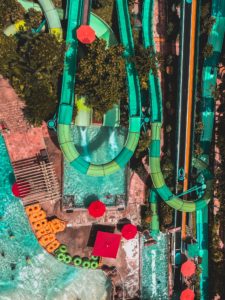Waterparks are an essential and exciting component of the attractions industry. Lifeguards are trained to exacting standards to save lives in the event of a drowning. They watch over their guests, singularly focused on preventing tragedy that can be a result of the inherent risks of aquatic recreation. But lifeguards are also ride operators, charged with the responsibility for operating waterslides, water coasters, surfing simulators, and other aquatic attractions bearing far more similarity to a traditional amusement ride than to a pool or beach. In 2019, International Ride Training implemented the iROC – Aquatic Operator (or iROC-AO) program to address the need for ride safety training, standards, and accountability on these types of aquatic attractions.
 Statistics show that waterslide operations are among the safest kind of recreation when it comes to the risk of drowning. Indeed, according to the U.S. Consumer Product Safety Commission, there were so few drownings associated with waterslide operations in the United States from 2015 through 2019, that it was impossible to make an accurate nationwide estimate of emergency room visits for these events. In short, thanks in no small part to the lifesaving skills continually reinforced in lifeguard certification programs, guests on a waterslide have an incredibly small chance of drowning during their experience. Unfortunately, the same is not true when it comes to other kinds of injuries associated with waterslide operation such as bumps and bruises, lacerations, or contusions associated with the ride experience. During this same time period, the CPSC estimates nearly 30,000 emergency room visits associated with these kinds of injuries incurred in connection with waterslides. Each of these injuries carries with it a toll with regard to guest safety and a cost in terms of potential liability and risk management. That’s where the iROC-AO program comes in.
Statistics show that waterslide operations are among the safest kind of recreation when it comes to the risk of drowning. Indeed, according to the U.S. Consumer Product Safety Commission, there were so few drownings associated with waterslide operations in the United States from 2015 through 2019, that it was impossible to make an accurate nationwide estimate of emergency room visits for these events. In short, thanks in no small part to the lifesaving skills continually reinforced in lifeguard certification programs, guests on a waterslide have an incredibly small chance of drowning during their experience. Unfortunately, the same is not true when it comes to other kinds of injuries associated with waterslide operation such as bumps and bruises, lacerations, or contusions associated with the ride experience. During this same time period, the CPSC estimates nearly 30,000 emergency room visits associated with these kinds of injuries incurred in connection with waterslides. Each of these injuries carries with it a toll with regard to guest safety and a cost in terms of potential liability and risk management. That’s where the iROC-AO program comes in.
 The iROC – Aquatic Operator program is not a lifeguarding certification. It focuses on the other hat that every lifeguard operating an aquatic attraction must wear: that of an operator working to dispatch riders, assist riders in unloading and exiting, or conveying ride units to the dispatch point using specialized lift conveyors. The iROC-AO program focuses aquatic operators in the waterpark on the Ten Critical Components of Ride Safety and shows how those concepts apply with equal force to an aquatic attraction in the waterpark environment so that our guests receive the same safe, professional, and efficient operational experience regardless of whether their ride unit operates on wheels or water. Concepts like Rider Screening, efficient Loading & Unloading, Restraint Device Security Verification, and the Pre-Dispatch Safety Check all apply equally to enhance rider safety on waterslides as they do in a traditional theme park or carnival. The iROC-AO program explains exactly how those concepts translate to the waterpark context in a manner that compliments, but does not replace, traditional lifeguarding skills.
The iROC – Aquatic Operator program is not a lifeguarding certification. It focuses on the other hat that every lifeguard operating an aquatic attraction must wear: that of an operator working to dispatch riders, assist riders in unloading and exiting, or conveying ride units to the dispatch point using specialized lift conveyors. The iROC-AO program focuses aquatic operators in the waterpark on the Ten Critical Components of Ride Safety and shows how those concepts apply with equal force to an aquatic attraction in the waterpark environment so that our guests receive the same safe, professional, and efficient operational experience regardless of whether their ride unit operates on wheels or water. Concepts like Rider Screening, efficient Loading & Unloading, Restraint Device Security Verification, and the Pre-Dispatch Safety Check all apply equally to enhance rider safety on waterslides as they do in a traditional theme park or carnival. The iROC-AO program explains exactly how those concepts translate to the waterpark context in a manner that compliments, but does not replace, traditional lifeguarding skills.
The iROC-AO program includes everything that is included in the iROC program. Contact International Ride Training for more information about becoming an iROC-AO facility.
